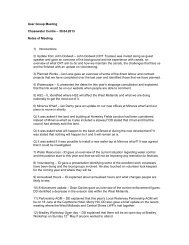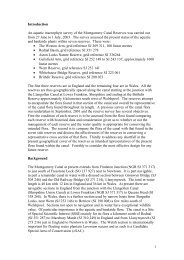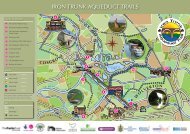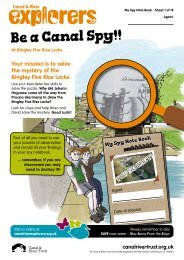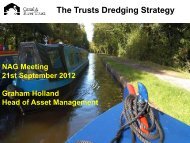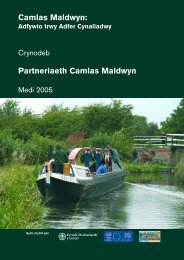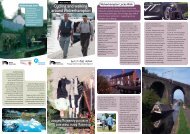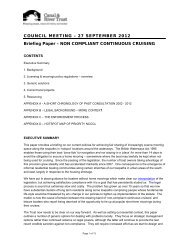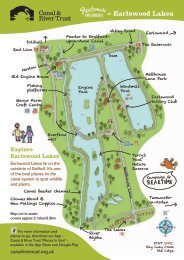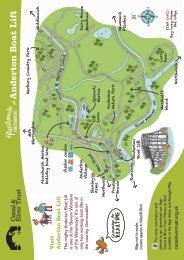Montgomery Canal Conservation Management Strategy (1.2MB PDF)
Montgomery Canal Conservation Management Strategy (1.2MB PDF)
Montgomery Canal Conservation Management Strategy (1.2MB PDF)
You also want an ePaper? Increase the reach of your titles
YUMPU automatically turns print PDFs into web optimized ePapers that Google loves.
24) <strong>Management</strong> will seek to attain an average width of one metre each side of the canal, for a target of 75% of the<br />
total length, south of Keeper’s Bridge.<br />
Marginal vegetation in offline reserves will further supplement this habitat. Because research indicates that marginal<br />
vegetation is relatively unaffected by boat movements, the area present will broadly reflect conservation value.<br />
Re-watering the dry section to Llanymynech will further increase the area of marginal vegetation, over a distance of<br />
approximately six kilometres.<br />
25) Innovative piling methods used on the Maesbury to Gronwen restoration will be used when appropriate. This has<br />
included piling in the middle of the bank, rather than water’s edge, and also double piling, with a front piling sunk in<br />
to water level.<br />
Maintenance of marginal vegetation will necessitate careful location of hard edge moorings or facilities, which should also<br />
refer to built heritage constraints.<br />
26) There will be a presumption in favour of allowing or encouraging soft vegetation edges, on both the off-side and<br />
towpath, except for built heritage or visitor facilities.<br />
Where hard edges are required on the towpath side, which could be for structural reasons, built heritage purposes,<br />
or moorings, consideration will be given to allowing a wider marginal zone to develop on the off-side.<br />
27) New off-line reserves will be designed to incorporate a full marginal fringe of vegetation.<br />
The area of marginal habitat likely to be created through the reserves is estimated at 2 hectares.<br />
7.3.4 <strong>Canal</strong> Fauna<br />
28) In order to better inform monitoring, continued research and survey will be encouraged and commissioned, as data is<br />
less comprehensive than for the flora.<br />
Some invertebrates are particularly sensitive to change in micro-environment, but often because of their dependence on<br />
a particular type or species of vegetation, or a requirement for high water quality. Practical measures will therefore focus<br />
on maintenance of the plant communities and water quality.<br />
There have been some significant declines in the canal bird population over the last twenty years, but these are thought<br />
to be primarily due to changes in agricultural practice on the adjacent land holdings. The continued development of the<br />
Environmental Stewardship Scheme and Tir Gofal will help to address this problem.<br />
7.3.5 Other habitats<br />
The new nature reserves will require a larger land take than the proposed aquatic habitat, as additional land will be<br />
required for the placement of soil from excavations.<br />
29) Additional land will be used to enhance other semi-natural habitats, especially native woodland and species rich<br />
grassland or marsh.<br />
Hedges and boundaries will be managed to maintain stock proof barriers, and will also take into account maintaining<br />
good towpath access, shading requirements of the canal flora, views from the canal, and the role in linking landscape<br />
together.<br />
106



